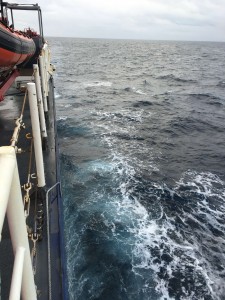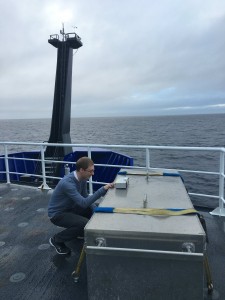by Joseph Niehaus
Relaxing on the bow of the ship brings a fresh breeze, plenty of sunshine, and a fine mist from the waves. When the waves on the open ocean break, small droplets of salt, water and biological material are lofted into the air. These droplets are transported vertically by the wind and may become seed particles for clouds or drift over continents. We call these droplets aerosols.

Waves breaking on the side of the ship create small droplets of salt, water and biological material called aerosols. Photo by Lauren Frisch.
Aerosol particles, depending on their size and likelihood to be absorbed by a cloud, can travel globally to impact foreign regions of the Earth. Some parts of the Amazon are fertilized by African desert dust, and wildfires in Canada generate soot that’s easily detected in Europe. All kinds of particles make it into the atmosphere, from organic bacteria to solid quartz. Volcanoes contribute significant amounts of sulfur and glass to the atmosphere. Particles that transport globally are usually in the 10s to 100s of nanometers range, which means they’re too small to see with the eye. However, they can still scatter ultraviolet light and small amounts of visible light, which has an effect on the radiation balance of the atmosphere.
Aboard the R/V Sikuliaq, I’m attempting to measure how much sea spray aerosol is generated by wave activity. This involves walking around the deck and waving my aerosol spectrometer in the air. It counts and measures the sizes of particles, because number and size are relatively easy quantities to measure. With this knowledge, we can make some good guesses about where the particles will go, and how much light it will scatter from the sun.

Joseph Niehaus uses a spectrometer to measure the number and size of aerosol particles. Photo by Lauren Frisch.
The size and amount of aerosol in the atmosphere may also affect human health. Lots of glassy particles can be scarring to lungs, and significant amounts of micron-sized aerosol causes the condition known as Black Lung. Because of this, the Environmental Protection Agency (EPA) regulates the concentration of aerosol particles (PM10 and PM2.5) that are safe in the atmosphere. PM2.5 is the particulate matter larger than 2.5 micrometers, about the size of flour dust. PM10 is the particulate matter larger than 10 micrometers. For reference, a strand of hair is about 100 micrometers wide. Typically, you would not notice breathing in PM2.5, but inhaling PM10 can make you cough. Thankfully the air out here is very clean, with virtually no particles larger than 5 micrometers.
Back in the lab, we have a mesocosm tank to test the amount of aerosol spray being produced by waves in the Pacific. The mesocosm is basically an aquarium with attachments that we fill with artificial seawater. We can generate aerosols with a waterfall which causes bubble bursting. The amount and type is very similar to ocean waves breaking, where trapped air generates bubbles which rise to the surface and burst. Using the same instruments on the voyage, we’re hoping to close the circle on how sea spray enters the atmosphere, altering weather patterns and climate conditions across all continents.
